We know that there are green grasshoppers found in nature. But do we actually know that there exist some grasshoppers which are larger than the usual size of the grasshoppers. In this article, we are going to talk about the 15 largest green grasshoppers found in nature.
15 Biggest Green Grasshoppers Worldwide
1) The Hedge Grasshopper
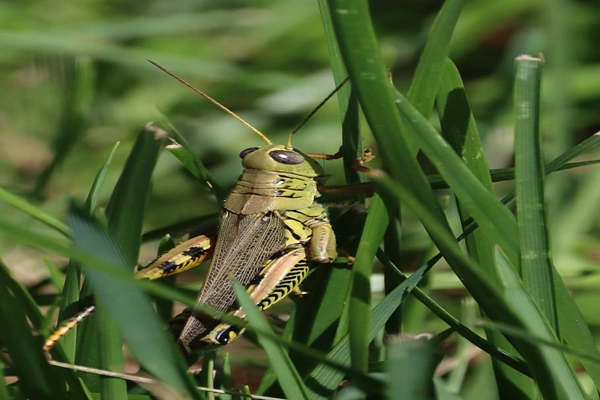
| Scientific Name | Valanga irregularis |
| Size | 3-3.5 inches |
| Location | Australia |
| Identification | It has green body with black markings |
At the top of the list is the Hedge grasshopper, scientifically known as Valanga irregularis, which is also known as the giant grasshopper and is the largest grasshopper in the world. They are found in Australia Continent, in grasslands and even forests.
Size of a female is around 3 inches and some have even reach 3.5 inches. The males are smaller as compared to females and only reach 2.15 inches.
These grasshoppers show a huge variety of colors and patterns with green or greyish bodies being found most frequently, however, their wings can be a variety of stripes or dots in grey, green, orange, or red.
They are usually found in solitary. So, they don’t cause much damage to plants or crops.
2) Chinese Grasshopper
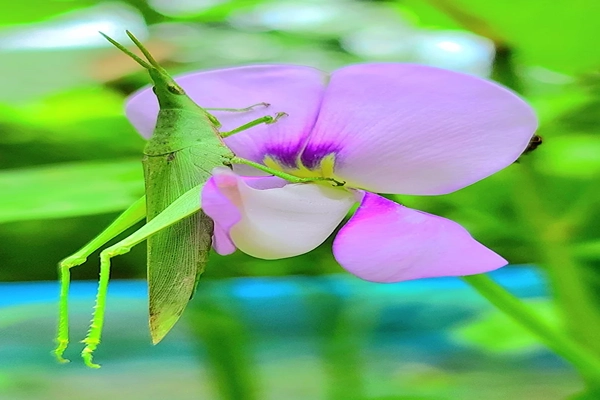
| Scientific Name | Acrida cinerea |
| Size | 3 inches |
| Location | China, Japan, and Indonesia |
| Identification | It has a unique body structure which makes it look like chinese |
The Chinese grasshopper scientifically known as Acrida cinerea is widespread across China, Indonesia, and Japan. Females can reach up to a length of 3 inches while males are usually 2 inches long.
They are commonly brown or green in color and have colorless wings. These grasshoppers have very long legs which help them to jump long distances in one go. They are often eaten across China and are thought to be as nutritional as poultry food.
However, they cause a lot of damage to crops such as sugar cane, cotton, and rice and are known as a pest species.
3) Coconut Grasshopper
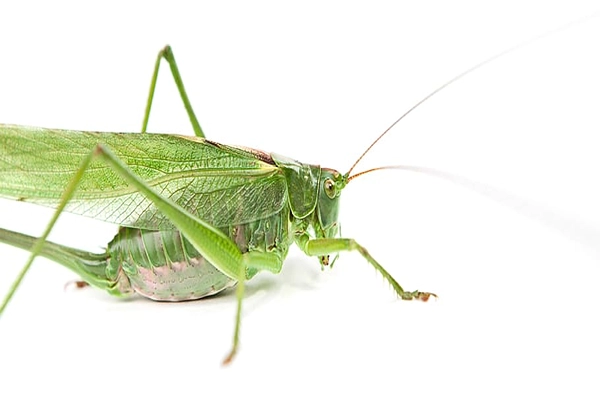
| Scientific Name | Pseudophyllanax iperialis |
| Size | 7.8 inches |
| Location | Cambodia |
| Identification | These grasshoppers have a big green body and wings |
The Coconut Grasshopper is an amazing insect found in some tropical areas and is distinguished by its incredible size. This grasshopper distinguishes out due to its amazing size in contrast to its smaller relatives.
It is immediately obvious thanks to its average body length of 8 to 10 centimeters, which can occasionally even reach 15 centimeters. Numerous elements, including an abundance of food supplies and a good habitat, are responsible for its enormous size.
The Coconut Grasshopper’s large size allows it to thrive in its environment and offers benefits such better mobility, improved predatory ability, and resistance to predators.
4) Giant Malaysia Katydid
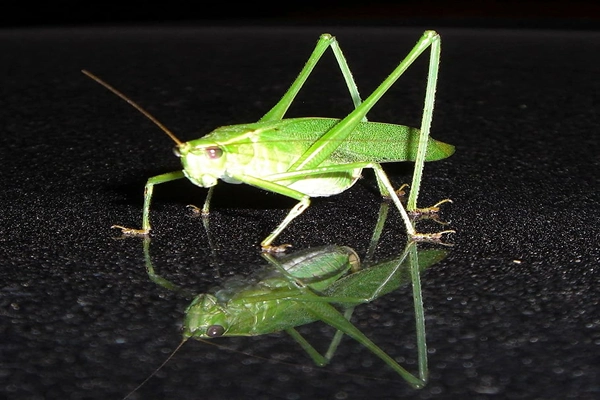
| Scientific Name | Arachnacris corporalis |
| Size | 5 inches |
| Location | Malaysia |
| Identification | These grasshoppers are known for their large legs |
An incredible bug known for its enormous size is the Giant Malaysia Katydid. The amazing size of this katydid species, which is mostly found in Malaysia’s lush jungles, makes it unique. It is one of the largest katydids in the world, with some individuals even growing larger than that.
The legs of the giant Malaysian katydid are also very large. The Giant Malaysia Katydid’s extraordinary size serves several functions. It first serves as a form of natural defense by frightening away predators with its frightening appearance.
Additionally, due to its huge size, it is easy to camouflage in the environment. These katydids can go farther in quest of food and mates because of the effective flight made possible by their enormous size.
5) Giant Green Grasshopper

| Scientific Name | Chondracis rosea |
| Size | 3.75-4 inches |
| Location | |
| Identification | These have green body with brown lines |
Giant Green Grasshopper scientifically known as Chondracis rosea, is recognized for its amazing size. This particular kind of grasshopper distinguishes out because of its large size. It is immediately noticeable thanks to its body length, which is between 10 and 12 cm.
Its body is a stunning shade of green, which furthers its distinctive appearance. The Giant Green Grasshopper benefits from its great size in a number of ways that help it survive.
It gives the grasshopper greater mobility and a wider range of motion, enabling it to hunt a bigger area for food and mates. It is also less likely to be a victim of predation because of its size, which serves as a prevention to potential predators.
6) Differential Grasshopper
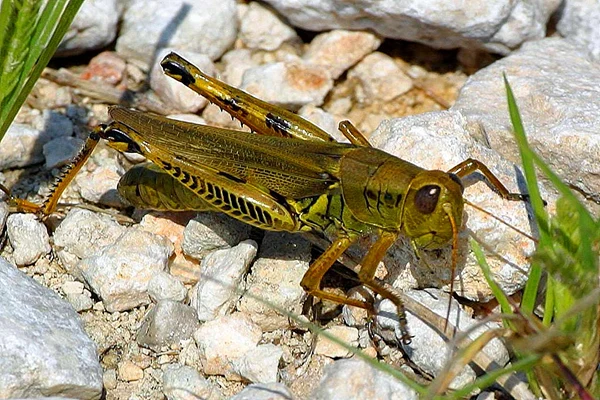
| Scientific Name | Melanoplus differentialis |
| Size | 1.5-2 inches |
| Location | Canada, Central America and Mexico |
| Identification | It has a green body with brown markings. |
Differential grasshoppers scientifically known as Melanoplus differentialis are large grasshoppers, with males reaching 1.5 inches and females almost 2 inches in length and they are widespread throughout Canada, Mexico, and Central America.
They have brown or red antennae. It is easy to figure out the age of these grasshoppers because they get darker when they get older.
They cause a lot of damage to the crops and are considered in the category of pests. Young grasshoppers of this species get mature faster than the green grasshoppers of other species.
7) Northern Grass Pyrgomorph
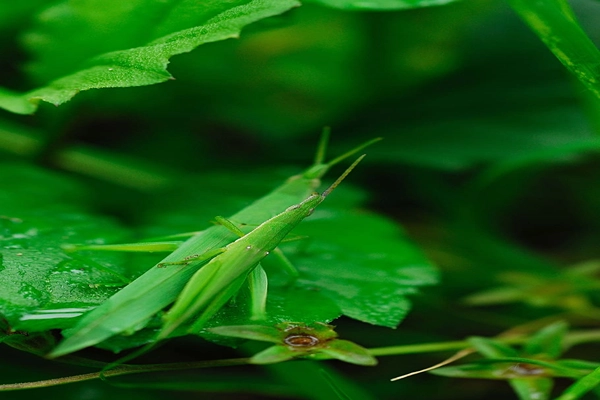
| Scientific Name | Atractomorpha similis |
| Size | 1.2-1.6 inches |
| Location | Australia |
| Identification | These grasshoppers have green body with large size. |
Northern Grass Pyrgomorph grasshopper scientifically known as Atractomorpha similis also sometimes known as the vegetable grasshopper can reach lengths of 1.2 to 1.6 inches.
They are usually found in Australia and can also often be found in gardens in those areas. They are completely green and their bodies narrow at each end, often they look like a leaf which helps them to camouflage instead of jumping from their predators.
These green grasshoppers prefer to eat broad, leafy plants and generally do not do much damage to the areas they frequent.
8) Two stripped Grasshopper
| Scientific Name | Melanoplus bivittatus |
| Size | 1-1.6 inches |
| Location | North America and Canada |
| Identification | They have a large green body with red legs. |
The two-striped grasshopper scientifically known as Melanoplus bivittatus gets its name from the two stripes that run. Their bodies are usually either brown or green and they also have a black stripe down their back legs.
Two-striped grasshoppers can reach lengths of 1 to 1.6 inches and are found mostly in Canada and North America. They eat a wide range of plants and crops and cause a lot of damage to the crops and are therefore classified as pests.
However, they do have quite a few predators, both in their egg stage and as adults, with small parasites, small mammals such as birds and rats all preying on them.
9) Long Horned Grasshopper
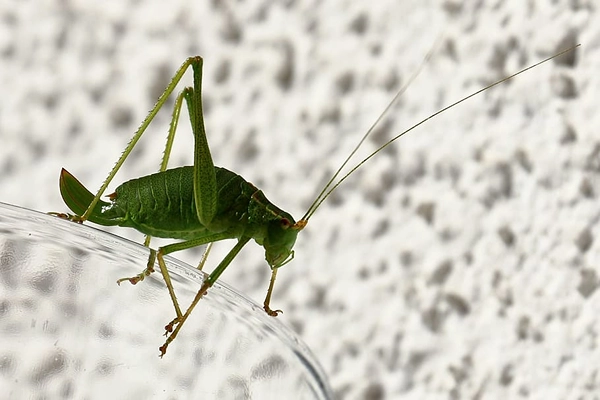
| Scientific Name | Tettigoniidae |
| Size | 4.5inches |
| Location | North America |
| Identification | They have all green body with long horns |
The long Horned Grasshopper scientifically known as Tettigoniidae is an interesting group of insects known for its unique features. These grasshoppers are known for their large, long antennae, which may almost exceed the length of their bodies.
There are many species in these grasshoppers, each with different patterns. These grasshoppers vary in size from medium to giant, measuring a few millimeters to several inches.
These grasshoppers use their long antennae for a variety of functions, including communication. These insects are found in the grassy area and are considered pest because they feed on crops.
10) Large Marsh Grasshopper
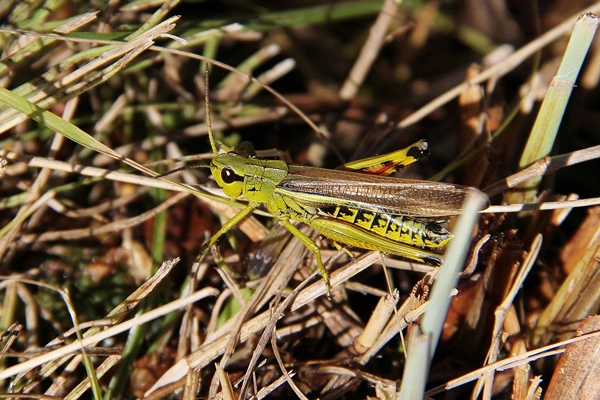
| Scientific Name | Stethophyma grossum |
| Size | 1.5 inches |
| Location | Marshlands of UK |
| Identification | They have green body with brown wings. |
The large marsh grasshopper is Scientifically known as Stethophyma grossum. They prefer to eat rushes and grass at the edge of the marshes where they also lay their eggs and are also found in the marshlands of the UK.
Large marsh grasshoppers are also found near the drainage. Males can reach lengths of up to 1 inch while females are much larger and can grow to be around 1.5 inches long.
Mostly these have a green colour body with a shade of brown or yellow or even pink sometimes.
11) Obscure Bird Grasshopper
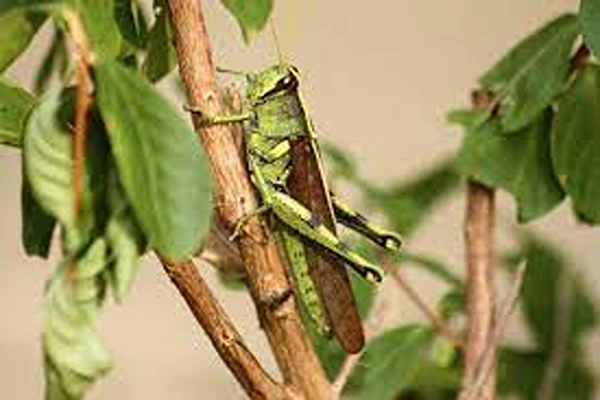
| Scientific Name | Schistocerca obscura |
| Size | 5-6.5 centimeters in females, 3.6-4.5 centimeters in males |
| Location | United States |
| Identification | It has a green grasshoppers with brown legs. |
These grasshoppers have a green body with a pale-yellow dorsal stripe that runs the length of it. The colour of their forewings is olive-green.
The dorsal stripe is sometimes lacking in females, who instead have brownish dots on their forewings. Males are somewhat smaller in size than females and have the same color.
The Rusty Bird Grasshoppers (Schistocerca alutacea) are sometimes mistaken with the Obscure Bird Grasshoppers. They are, nevertheless, greater in size than the latter.
12) Larger Fork-tailed katydid
| Scientific Name | Scudderia furcata |
| Size | 3.9 centimeters in females; 3.1 centimeters in males |
| Location | North America |
| Identification | It has large green body with long horns |
Larger Fork-tailed Grasshoppers are a species of Spurthroat Grasshoppers that are also known as “Fork-tailed Locust.” They are commonly seen in thick vegetation growing beside wetlands and streams.
These grasshoppers have lengthy wings and a brown body with a reddish hue on the upperparts on occasion. Their wings are darker towards the place where they join to the body and lighten towards the end.
They are sexually dimorphic, with males being much smaller than females. Males also lack the furcula that females have.
13) Short winged cone head Grasshopper
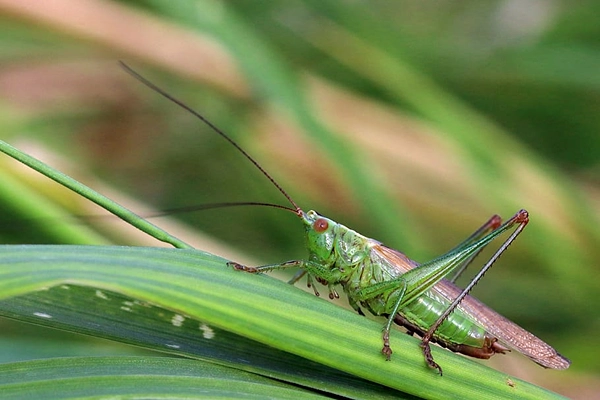
| Scientific Name | Conocephalus dorsalis |
| Size | 11-18mm |
| Location | North America |
| Identification | It has green body with brown stripes |
The short-winged conehead grasshopper scientifically known as Conocephalus dorsalis is an interesting grasshopper which is found throughout North America. It is different from other grasshoppers by its unique cone-shaped head and short wings.
These grasshoppers are often brown or green in color, allowing them to camouflage in with their surroundings and help them keep safe through predators. They have strong legs that allow them to jump long distances and stay away from predators.
These are herbivorous and feeds on a range of plants and grasses. They create a chirping melody in the evenings which tells about their presence.
14) Glassy-winged Toothpick Grasshopper

| Scientific Name | Stenacris vitreipennis |
| Size | 3-4cm |
| Location | North and South America |
| Identification | It has a green body with transparent wings. |
Glassy-winged Toothpick Grasshoppers, also known as “Glassy-winged locusts,” are a kind of Spurthroat Toothpick Grasshopper that prefers semi-aquatic vegetation such as pickerelweed and cattails.
These grasshoppers have a long, thin body with a pointed head and sword-like antennae. They may resemble gomphocerines in appearance, but the position of their spine distinguishes them.
Their bodies are green or brownish-green, with a black or light dorsal stripe. Both sexes seem identical; only the females are significantly bigger.
15) Clipped-wing Grasshopper

| Scientific Name | Metaleptea brevicornis |
| Size | 3.6-5.3 centimeters in females; 2.5-3.8 centimeters in males |
| Location | North America |
| Identification | This has a green body with with brown linings. |
The Clipped-wing Grasshoppers are the only indigenous species of quiet Slant-faced Grasshoppers in the United States. They are typically found in tall grasses near areas of water such as rivers and ponds.
These grasshoppers have a sexual dimorphism, with females being bigger than males. They can be green or brown, with males always having a brown upper body and green laterals. Their antennae are often sword-shaped and rusty brown in colour.
Clipped-wing The angled tip forewings of grasshoppers differentiate them from other long-winged grasshoppers in Florida.
Conclusion
These are the top 15 largest green grasshoppers found in the nature and their big size play a very important role in their life. We hope you like the post. We will back with another exciting articles.
Also Read:

I am a person who effortlessly combines creativity, hard work, and a strong interest in nature. My writing takes you on incredible journeys where science and imagination come together. I am driven by a deep curiosity to understand the wonders of life, and dive into the details of biology with thorough research and a genuine appreciation for nature. My articles are full of vivid descriptions and fascinating facts, making the world of biology come alive. Whether I am writing articles, essays, or fiction, my work sparks curiosity and shows the incredible beauty of our natural world.
